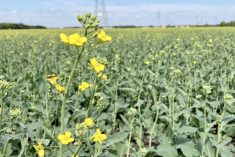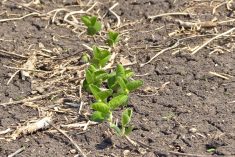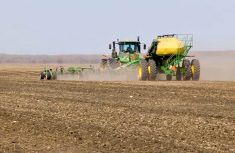MarketsFarm — An early snowstorm may have been the last straw for Manitoba livestock producers looking to put up feed ahead of winter.
While the foot or more of heavy snow that blanketed much of the province over the Thanksgiving weekend has melted, saturated fields continue to limit corn silage harvests and hay cutting.
“Feed supplies were already a challenge moving into the storm, and the storm definitely won’t help,” said Carson Callum, general manager for Manitoba Beef Producers.
After dealing with drought conditions earlier in the year, many rural municipalities in central and western Manitoba had already declared states of emergency in August due to poor hay crops.
Read Also

Senft to step down as CEO of Seeds Canada
Barry Senft, the founding CEO of the five-year-old Seeds Canada organization is stepping down as of January 2026.
Looking across the province “it’s fairly dire, as far as the amount of feed available,” said John MacGregor, extension support with the Manitoba Forage and Grassland Association.
“We didn’t get a great first cut, and didn’t get much of a second cut,” he added, noting the rains and snow in September and October will limit how much of a final cut comes off.
The ground freezing up would allow producers to get on the field, but alfalfa would lose all of its leaves in that scenario, said MacGregor. There may be some grass they can harvest, but he noted it would be difficult to dry the grass down at this time of year.
“We kept wishing for rain, and now that we have it… ‘Be careful what you wish for,'” said MacGregor.
Corn silage was going to be a saving grace for many producers and make up for the hay shortfall, he said, but the silage harvest has been stalled at about 30 to 40 per cent complete.
Grain corn producers with poor crops may be looking to take some off as silage instead if it looks to be more profitable, but they are facing the same terrible harvest conditions.
Straw from annual crops and stover from the grain corn harvest could also be alternate feed sources, but with the wet fields, MacGregor said grain farmers may not want their fields rutted up any more.
Given the tight feed situation, “we will likely see some herds reduced throughout the province, just because the price of hay is fairly high and the availability of alternative feeds is not as available as guys would like,” said MacGregor.
“It will be a struggle for a lot of guys.”
Callum also expected to see herd downsizing and calves moved to market earlier than usual.
“We’re still assessing the situation, and producers are trying to stay resilient and help out their neighbours as best as they can,” said Callum.
— Phil Franz-Warkentin reports for MarketsFarm, a Glacier FarmMedia division specializing in grain and commodity market analysis and reporting.















